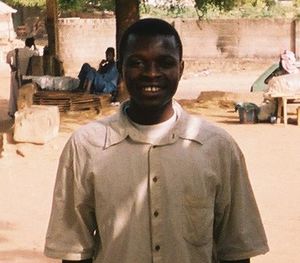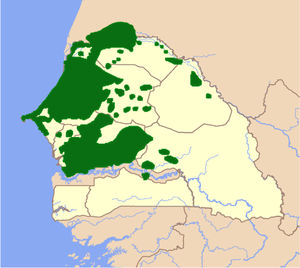ولوف (شعب)
 أبرز الولوف:
أبرز الولوف:عبد الله واد، جبريل ديوپ مامبيتي | |
| المناطق ذات التجمعات المعتبرة | |
|---|---|
| 5,689,710[1] | |
| 287,658[1] | |
| 229,715 | |
| اللغات | |
| ولوف، الفرنسية، الإنگليزية، والعربية الحسانية | |
| الدين | |
| الإسلام السني مع الصوفية (90%)، الوثنية (6%)، المسيحية (2%)[2] | |
| الجماعات العرقية ذات الصلة | |
| لـِبو، سرر | |

ولوف Wolof هم جماعة عرقية في السنغال، گامبيا، وموريتانيا.
في السنغال، يشكل الولوف الأكثرية العرقية بنحو 43.3% من التعداد.[3]
وفي گامبيا، فإن نحو 16% من السكان هم من الولوف. وهنا هم أقلية، حيث أن المندينكا هم الأكثرية بنحو 42% من السكان، إلا أن لغة الولوف وثقافتهم لهما تأثير هائل بسبب غلبتها في بانجول، العاصمة الگامبية، حيث يتركز غالبية الولوف.[4]
في موريتانيا، فنحو 8% من السكان هم من الولوف. ويعيشون أساساً في المنطقة الجنوبية الساحلية من البلد.
الدولة التاريخية
امبراطورية الولوف كانت دولة قروسطية في غرب أفريقيا حكمت أجزاء من السنغال وگامبيا من تقريباً سنة 1350 حتى 1890. وبينما اتحدت في دولة واحدة لجزء بسيط من تلك الفترة، إلا أن تقاليد الحوكمة والطبقات والثقافة للولوف تهيمن على تاريخ شمال ووسط السنغال لمعظم الثمانمئة عاماً الماضين. وقد كان أفولها النهائي على يد القوات الاستعمارية الفرنسية في عقود ع1870-ع1890 التي أيضاً كانت بداية تشكـُّل السنغال كدولة موحدة.
الثقافة
The Wolof people’s traditional culture and practices have survived the colonial era and are a strong element of the Senegalese culture .
اللفة
"Wolof" is the name of the native language of the Wolof people. At least 50% of Senegal's population are native speakers of Wolof. Members of neighboring groups are often bilingual and can understand Wolof. Wolof culture and language have an enormous influence, especially in urban areas. Wolof is strongly linked to Serer and Fulani in structure بتأثير طفيف من اللغة العربية.
أبرز أبناء الولوف
- Battling Siki (Baye Fall)
- عبد الله واد
- Anna Kingsley
- Seckou Keita (musician)
ببليوگرافيا
- Cissé, Mamadou (2004). Dictionnaire Français-Wolof. Paris: L’Asiathèque. ISBN 2-911053-43-5.
{{cite book}}: Cite has empty unknown parameter:|coauthors=(help) - Cissé, Mamadou (1994). Contes wolof modernes. Paris: L’Harmattan. ISBN 2-7384-3016-3.
{{cite book}}: Cite has empty unknown parameter:|coauthors=(help) - Malherbe, Michel (1989). Parlons Wolof - Langue et culture. Paris: L'Harmattan. ISBN 2-7384-0383-2.
{{cite book}}: Unknown parameter|coauthors=ignored (|author=suggested) (help) - Bichler, Gabriele Aïscha (2003). Bejo, Curay und Bin-bim? Die Sprache und Kultur der Wolof im Senegal (mit angeschlossenem Lehrbuch Wolof). Europäische Hochschulschriften. Vol. 90. Frankfurt am Main: Peter Lang Verlagsgruppe. ISBN 3-631-39815-8.
{{cite book}}: Cite has empty unknown parameter:|coauthors=(help) - Fal, Arame (1990). Dictionnaire wolof-français (suivi d'un index français-wolof). Paris: Karthala. ISBN 2-86537-233-2.
{{cite book}}: Unknown parameter|coauthors=ignored (|author=suggested) (help) - Goetz, Rolf (1996). Senegal - Gambia: Praktischer Reiseführer an die Westküste Afrikas. Frankfurt am Main: Verlag Peter Meyer Reiseführer. ISBN 3-922057-09-8.
{{cite book}}: Cite has empty unknown parameter:|coauthors=(help)
